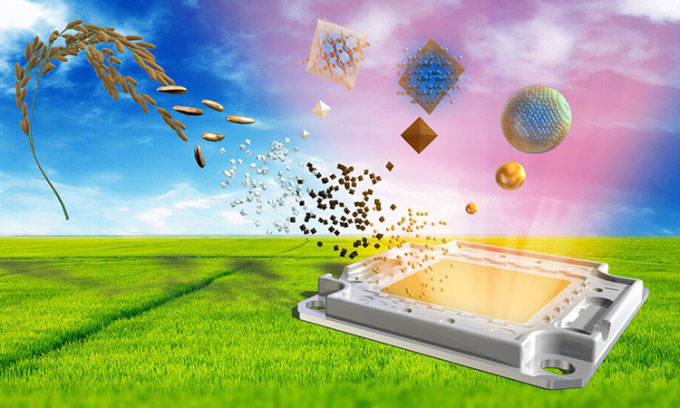A research team from Hiroshima University utilizes discarded rice husks to develop environmentally friendly orange-red LED lights.
The rice milling process generates approximately 100 million tons of rice husk waste globally each year. Scientists have developed a method to recycle rice husks to create the world’s first silicon quantum dot LED, as reported by Techxplore on April 11. This new method transforms agricultural waste into modern light-emitting diodes at a low cost and with environmental friendliness.

The research team at Hiroshima University has created the world’s first LED using rice husks and chemical components. (Photo: ACS Sustainable Chemistry & Engineering)
The team from the Center for Natural Science Research and Development at Hiroshima University (Japan) announced their findings in the journal Sustainable Chemistry and Engineering of the American Chemical Society (ACS).
“Quantum dots (fluorescent semiconductor nanocrystals) typically contain harmful materials such as cadmium, lead, or other heavy metals. Therefore, when using nanomaterials, experts often consider environmental concerns. Our process and method for fabricating quantum dots (QDs) helps mitigate these concerns,” said Ken-ichi Saitow, a member of the research team and a chemistry professor at Hiroshima University.
Since the discovery of porous silicon (Si) in the 1950s, scientists have identified its applications in lithium-ion batteries, luminescent materials, biosensors, and drug delivery systems. Non-toxic and abundant in nature, Si exhibits luminescent properties derived from nanoscale structures (quantum size) that act as semiconductors.
Recognizing current environmental concerns surrounding QDs, the research team sought new methods to create environmentally friendly QDs. They found that rice husk waste is a source of high-purity silica (SiO2) and good Si powder.
The research team combined milling, thermal treatment, and chemical etching to process silica from rice husks. First, they milled the rice husks and extracted silica powder by burning the organic compounds of the husks. Next, they heated the silica powder in an electric furnace to obtain Si powder through a reduction reaction.
The pure Si powder was then reduced to a size of 3 nanometers using chemical etching. Finally, its surface was treated to achieve good chemical stability and high dispersion in solvents. The 3-nanometer crystalline particles will produce SiQDs that emit light in the orange-red spectrum with high luminescent efficiency—over 20%.
“This is the first study to develop LEDs from rice husk waste. The current method could become a promising way to develop environmentally friendly quantum dot LEDs from natural products,” Saitow stated.
The LEDs are assembled into a series of material layers. The indium-tin oxide (ITO) glass substrate serves as the anode of the LED. This material is a good conductor while being sufficiently transparent to transmit light. Additional layers are coated onto the ITO glass, including the SiQD layer. Finally, an aluminum film acts as the cathode.
In the near future, the team of experts plans to find ways to enhance the luminescent efficiency in SiQDs and LEDs. They will also explore the potential to produce SiQDs in colors other than orange-red.
The experts believe that this new method could also be applied to other types of plants in the future, such as bamboo, sugarcane, wheat, barley, or grasses containing SiO2. These natural products, along with their waste, have the potential to be transformed into non-toxic optoelectronic devices. Ultimately, the scientists aim to commercialize this environmentally friendly method for producing luminescent devices from discarded rice husks.


















































